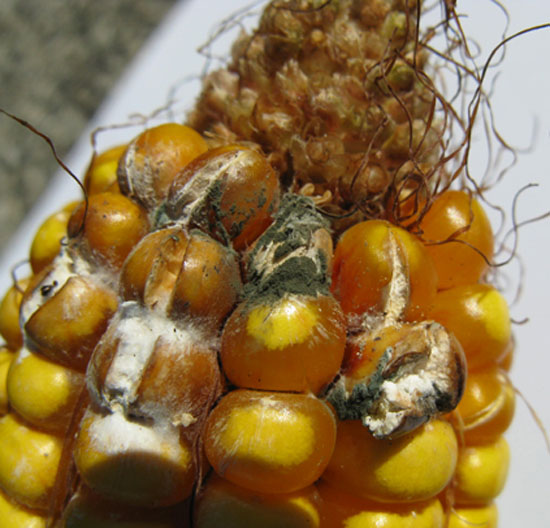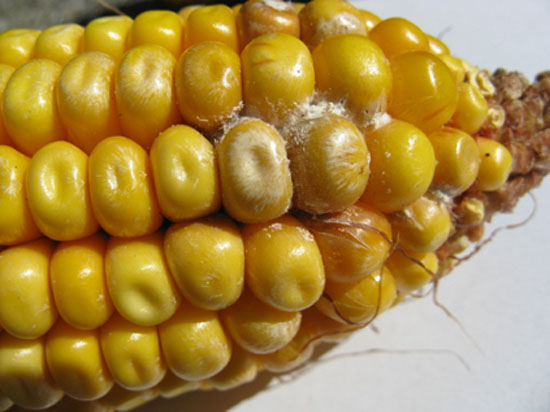Corn ear molds have been observed at the University of Illinois Northwestern Research and Education Center in Monmouth. In plant pathology, we like to talk about the disease triangle.
Not only must a susceptible hybrid and the pathogen be present, but weather conditions must be conducive for disease development. While moderate temperatures and moist weather favor Gibberella and Diplodia ear molds, hot, dry weather as we've experienced in 2011 favors Aspergillus and Fusarium ear molds.
Although ear mold fungi can reduce yield by consuming grain dry matter, of far greater importance is that many of the fungi produce chemicals called mycotoxins, byproducts that are toxic to humans and other animals.
To scout for ear molds, choose several locations in the field and peel back the husk leaves from the ears of several plants. If you observe mold, proper diagnosis can help you determine your risk of mycotoxin contamination, as not all ear mold fungi produce mycotoxins. The University of Illinois Plant Clinic can diagnose ear molds.
|
|
Aspergillus ear mold. Aspergillus ear mold is caused by two fungal species, Aspergillus flavus and Aspergillus parasiticus.
The fungus survives and sporulates on infected crop residue. Fungal spores are disseminated through the air and can infect kernels either by growing down the silk channel or by entering insect-feeding wounds. Aspergillus ear mold is favored by drought, high temperatures, and high relative humidity during pollination and grain fill.
Signs of Aspergillus should be easy to see; they most often develop near the ear tip (due to insect feeding) or at any spot where the ear has been damaged. Aspergillus produces a powdery grey-green growth on and around kernels.
The presence of Aspergillus ear mold indicates the potential for mycotoxin contamination in your crop. Some strains of A. flavus and A. parasiticus produce aflatoxin, a mycotoxin that is toxic to liver tissue and carcinogenic.
An inexpensive way of determining whether you have risk of aflatoxin contamination is to illuminate infected grain with a blacklight (365 nm). However, this method is neither quantitative nor accurate, as some strains of A. flavus fluoresce but do not produce mycotoxins. Chemical analysis is required to determine whether your corn contains aflatoxin.
Disease control includes residue management, such as chopping or burying residue to aid decomposition. Also, anything you can do to minimize stress in your corn plants, such as planting drought-tolerant hybrids, irrigating, ensuring adequate soil fertility, and controlling insects through Bt traits, can reduce your risk of Aspergillus ear mold.
|
|
Fusarium ear mold. Fusarium ear mold is caused by the fungus Fusarium verticillioides and other Fusarium species. The fungus survives on crop residue, and infection occurs primarily through silks and insect damage. While symptoms can appear under a wide range of conditions, they are most severe when weather is hot and dry.
Symptoms include a distinct "starburst" pattern of streaks radiating from the tops of kernels and close to the ear tips. Signs of the fungus include cottony fungal growth that ranges from white to pink.
Some Fusarium species produce mycotoxins called fumonisins, which can be toxic or even fatal to livestock.
Disease control includes planting disease-tolerant hybrids, rotating crops, managing residue, and controlling insects through Bt traits.
I have ear mold--what can I do? Unfortunately, once mycotoxins are present in grain, they are not broken down by the drying process, but there are several actions you can take to stop their production.
Start with clean grain bins, and store contaminated grain separately. Set your combine to kick out light kernels, and clean grain before storage. If you anticipate large-scale infection, harvest at higher moisture levels (25%), and dry at high temperatures--to 18% moisture for short-term storage and 15% for long-term storage--as soon as possible to stop fungal growth and the potential for additional mycotoxin production.
If you suspect Aspergillus ear mold, dry grain to 14%. After drying, cool grain to 30°F as soon as possible to retard fungal growth.
Test your grain to get an accurate measurement of the mycotoxin concentration. This will help in determining how the grain can be used.

 A corn ear infected by Aspergillus corn mold. (University of Illinois photo)
A corn ear infected by Aspergillus corn mold. (University of Illinois photo) A corn ear infected by fusarium ear mold. (University of Illinois photo)
A corn ear infected by fusarium ear mold. (University of Illinois photo)




Post a comment
Report Abusive Comment